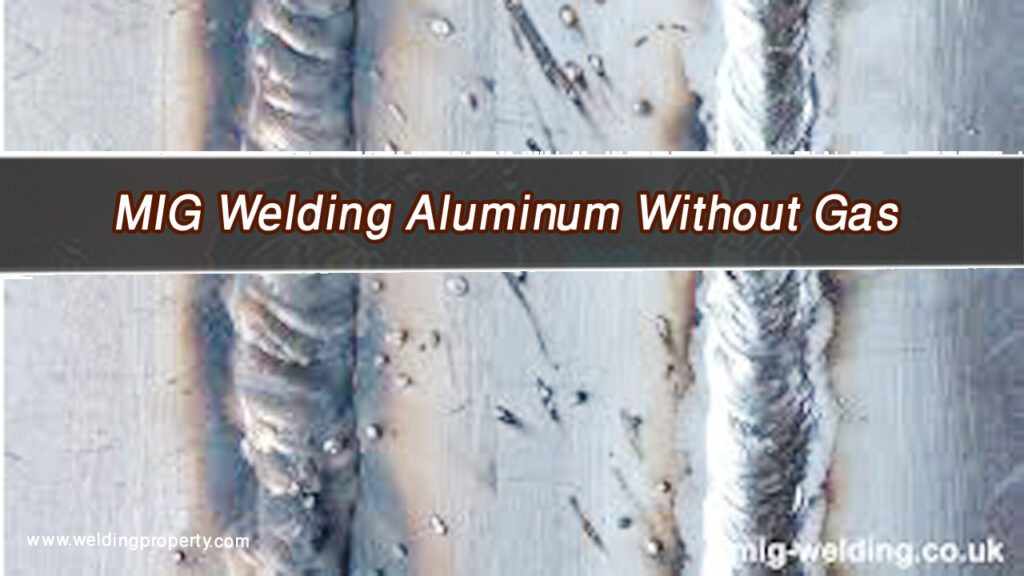When I first thought about welding aluminum without gas, I was skeptical. Aluminum is tricky to weld even under ideal conditions, and gas-shielded MIG welding is the preferred method for a reason. However, circumstances sometimes call for alternative approaches, and learning how to MIG weld aluminum without gas can be a game-changer.

Whether you’re working in a remote area where gas cylinders aren’t practical or you’re simply exploring cost-effective options, it’s possible to weld aluminum without gas if you understand the right techniques. In this article, I’ll guide you through the process, share expert tips, and explain what you need to know to get clean and durable results.
Why Consider MIG Welding Aluminum Without Gas?
Let’s face it—MIG welding aluminum with shielding gas provides superior results. But there are some situations where welding without gas might make sense:
- Cost Efficiency: Gas canisters and refills add to expenses. For hobbyists or small-scale welders, skipping gas might save money.
- Portability: Welding in outdoor or remote locations can make using gas shielding impractical.
- Quick Repairs: When time is limited, using flux-cored aluminum wire can eliminate the need for setting up a gas system.
While this approach isn’t ideal for every project, understanding how to weld aluminum without gas can expand your skills and offer versatility in specific scenarios.
Challenges of Welding Aluminum Without Gas
Before diving into techniques, it’s essential to understand the challenges you’ll face:
- Oxidation: Aluminum quickly forms an oxide layer that can interfere with welding. Without shielding gas, this issue becomes more pronounced.
- Porosity: The lack of gas shielding increases the likelihood of porous welds.
- Appearance: Welds without gas often lack the smooth, clean finish of traditional MIG welding.
- Strength: Improper technique can result in weak welds that compromise the structural integrity of your work.
Knowing these challenges upfront can help you troubleshoot and improve your results.
Tools and Materials for Welding Aluminum Without Gas
To succeed with MIG welding aluminum without gas, you’ll need the right setup. Here’s what I recommend:
Flux-Cored Aluminum Wire
Since you won’t have shielding gas, a flux-cored aluminum wire is essential. The flux acts as a shield to protect the weld from atmospheric contaminants.
A Reliable MIG Welder
Make sure your MIG welder is compatible with aluminum welding. A machine with adjustable settings for voltage and wire speed is ideal.
Clean Aluminum Workpieces
Start with aluminum that is free of dirt, oil, and oxide. Use a dedicated aluminum wire brush to remove the oxide layer before welding.
Proper Protective Gear
Aluminum welding produces high-intensity light and fumes, so wear appropriate safety gear, including a welding helmet, gloves, and respirator.
Heat Management Tools
Aluminum dissipates heat quickly, which can make it harder to maintain a steady weld pool. Consider using heat sinks or clamps to manage heat distribution.
How to MIG Weld Aluminum Without Gas
Welding aluminum without gas requires careful attention to technique and setup. Follow these steps for the best results:
Prepare Your Workspace
Start by setting up a clean and organized welding area. Make sure there’s adequate ventilation, as the flux in the wire will produce fumes.
Clean the Aluminum Thoroughly
Aluminum oxide melts at a much higher temperature than aluminum itself, so cleaning the surface is crucial. Use a stainless steel wire brush or an abrasive pad specifically for aluminum.
Select the Right Flux-Cored Wire
Choose a wire diameter appropriate for your project. Thicker wires are better for heavy-duty applications, while thinner wires are ideal for detailed work.
Adjust Your Welder Settings
Proper settings can make or break your weld. Use a lower voltage and higher wire feed speed to compensate for aluminum’s heat dissipation. Practice on scrap material to fine-tune your settings.
Maintain a Steady Welding Motion
Welding aluminum without gas requires precision. Use a consistent push technique, keeping the torch at a slight angle to guide the molten metal forward. Avoid erratic movements, as they can cause defects.
Manage Heat Effectively
Monitor the heat input closely. If the aluminum overheats, it can warp or burn through. Use short welds (also called “stitch welding”) and allow the material to cool between passes.
Inspect Your Welds
After completing the weld, check for porosity, cracks, and weak spots. If necessary, grind and re-weld any defective areas.
Pros and Cons of Welding Aluminum Without Gas
Pros
- Cost-Effective: Eliminates the need for gas and associated equipment.
- Portable: Ideal for remote or outdoor projects.
- Quick Setup: Flux-cored wire simplifies the welding process.
Cons
- Less Clean: Welds are often less aesthetically pleasing.
- Weaker Welds: Lack of shielding gas can compromise strength.
- Higher Skill Requirement: Demands greater precision and control.
Expert Tips for Better Results
Over the years, I’ve learned a few tricks to improve the outcome of welding aluminum without gas:
- Preheat the Material: Using a heat gun or torch to preheat the aluminum can make it easier to establish a weld pool.
- Work in Short Bursts: Aluminum dissipates heat quickly, so use short, controlled welds to avoid overheating.
- Practice on Scrap Pieces: Experiment with different settings and techniques before working on your actual project.
- Invest in Quality Wire: Cheap flux-cored aluminum wire often produces poor results.
MIG Welding Aluminum Without Gas vs With Gas
| Aspect | Without Gas | With Gas |
|---|---|---|
| Cost | Lower | Higher |
| Portability | High | Limited |
| Weld Quality | Moderate | High |
| Ease of Use | Requires more skill | Easier for beginners |
| Applications | Small-scale or quick repairs | Professional and precise work |
Common Applications for Welding Aluminum Without Gas
While it’s not suitable for every project, welding aluminum without gas can work well for:
- DIY Projects: Home repairs, custom fabrications, or artistic metalwork.
- Field Repairs: When portability and speed are more important than aesthetics.
- Small Businesses: For welders on a budget or those just starting out.
Conclusion
Welding aluminum without gas is a challenging but rewarding skill to master. While it doesn’t offer the same level of precision or strength as gas-shielded welding, it can be a practical solution in specific situations.
The key is preparation, practice, and patience. With the right tools, techniques, and a willingness to learn, you can achieve solid results even without shielding gas. Whether you’re a hobbyist exploring new methods or a professional looking for versatile solutions, welding aluminum without gas is worth adding to your skillset.
So, grab your flux-cored wire, clean your workpiece, and get welding—you might be surprised at what you can create.
FAQs
Can you weld aluminum without gas?
Yes, you can weld aluminum without gas by using flux-cored aluminum wire, which provides shielding through its flux coating.
Is welding aluminum without gas as strong as gas-shielded welding?
Not quite. Welds without gas tend to have lower strength and more imperfections, but they can still be functional for certain applications.
What’s the biggest challenge of welding aluminum without gas?
The biggest challenge is controlling porosity and achieving a clean weld without oxidation interfering.
Can beginners try welding aluminum without gas?
Beginners can try, but it requires more precision and practice than traditional MIG welding with gas.
What type of wire is used for welding aluminum without gas?
Flux-cored aluminum wire is specifically designed for welding aluminum without shielding gas.

Endow Russel the owner chief editor of giftendow.com . I am a mechanical engineer and assign to an local firm with much experience in welding and industrial equipment.

